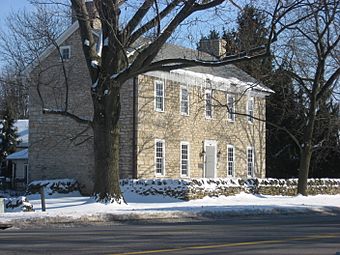Samuel Davis House (Norwich Township, Franklin County, Ohio) facts for kids
Quick facts for kids |
|
|
Samuel Davis House
|
|

Front of the house
|
|
| Location | 4264 Dublin Road, Columbus, Ohio |
|---|---|
| Area | 1.2 acres (0.49 ha) |
| Built | 1816 |
| Architect | Samuel Davis |
| Architectural style | Federal |
| NRHP reference No. | 74001488 |
| Added to NRHP | February 15, 1974 |
The Samuel Davis House is a very old and special farmhouse. It is located near Columbus and Dublin in Franklin County, Ohio. This house was once home to a brave pioneer named Samuel Davis. It is important because it is one of the oldest buildings in the county. It has also been named a historic site.
Contents
Meet Samuel Davis, a Pioneer
Samuel Davis was born in Litchfield, Connecticut in 1763. When he was young, he learned to be a silversmith. This means he made things out of silver. Later, he joined the Continental Army. He fought bravely in the American Revolution.
After the war, Samuel Davis traveled west. He went to a place that is now Kentucky. There, he traded silver items with Native Americans. He met many famous frontiersmen during this time. These included Daniel Boone, Nathaniel Massie, and Simon Kenton.
Samuel Davis's New Home
Samuel Davis also worked as a scout for a military group. This group was led by Simon Kenton. While scouting, he found the land where his house now stands. He bought this land on March 12, 1814. He then built his house there the next year.
The Samuel Davis House
The Samuel Davis House is a simple, rectangular building. It is made of stone. The stone came from Samuel Davis's own property. The walls of the house are very thick, about 18 inches!
Unique Architecture
The house was built in the Federal style. This style was popular in the United States after the Revolutionary War. It is the oldest stone house still standing in Franklin County.
In 1974, the Samuel Davis House was added to the National Register of Historic Places. This means it is a very important building in American history. It was recognized for its special architecture. Many other historic places are also found along Dublin Road.

